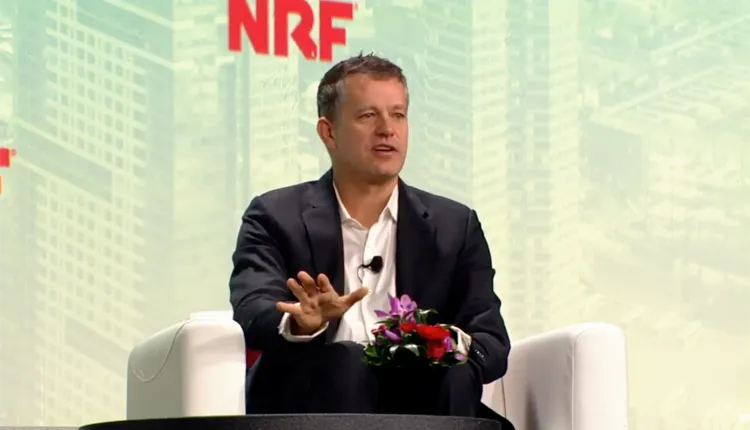MINNEAPOLIS — Target Corp. has long been known for its unmatched marketing prowess, displayed through campaigns that are perhaps the most creative, distinctive and effective in all of retail. That reputation was achieved and maintained by a succession of fabled marketing executives, beginning with John Pellegrene and continuing with Michael Francis and Jeff Jones.
Rick Gomez, who succeeded Jones as chief marketing officer in 2017 and added the title of chief digital officer in January 2019, has demonstrated that he belongs in that elite company by leading a number of highly successful initiatives that have been a critical part of Target’s resurgence since he joined the retailer as senior vice president of brand and category marketing in 2013. In recognition of his role in Target’s rebound and ongoing success, Mass Market Retailers has named Gomez its Marketer of the Year for 2019.
Before joining Target, Gomez had held senior-level marketing positions at such leading brands as MillerCoors, PepsiCo Inc. and Quaker Oats Co. What attracted him most to the retailer, he says, was its values. “I wanted to go somewhere that aligned with my personal values,” he recalls. “Target is a brand that’s really empathetic, optimistic and inclusive — and that’s a big differentiator for us because it’s not something another brand can easily duplicate. Those are values that Target lives every single day.”
Initially Gomez was responsible for the marketing of all of Target’s merchandise categories as well as playing a leadership role in seasonal marketing campaigns. He continued Target’s tradition of forming major creative collaborations through exclusive partnerships with designers and music artists. Examples include a highly successful collaboration with designer Lilly Pulitzer in 2015 followed by Target’s live music video with Gwen Stefani during the 2016 Grammy telecast.
Fittingly, last fall Target observed the 20th anniversary of its first designer partnership, with architect Michael Graves, a collaboration that has been followed by more than 175 designer partnerships since. To celebrate what has truly been a uniquely successful marketing and merchandising strategy, one that has defied duplication by Target’s competitors, the retailer revived nearly 300 original, iconic items from 20 of the most notable designer partnerships. As Gomez notes, making great design accessible to everyone has set Target apart during the last two decades.
Just a few weeks after the launch of its designer partnerships celebration, the company introduced its Target Circle loyalty program nationwide. The program, which requires no membership fee, was developed with the input of Target guests who shared with the retailer what they considered the most valuable benefits and perks. Gomez takes pride in the instant success of the program, which had already enrolled more than 2 million guests who completed more than 14 million transactions in the course of an 18-month pilot before going nationwide.
In November and December, Target kicked off what Gomez says is the most inclusive holiday campaign in the company’s history. “We’re celebrating the spirit of inclusivity that we’re known for at Target,” Gomez said at the time the campaign was launched. “No matter what our guests celebrate, how they celebrate, or who they choose to celebrate with, we want them to know that Target is thinking of them this holiday season.”
The campaign also demonstrated Target’s deft ability to weave iconic music into its advertising, with multi-Grammy Award-winning artist Sam Smith featured in the English language version and Mexican singer and actress Danna Paola performing in the Spanish-language spot.
When Gomez joined Target, the retailer was struggling with the impact of a major data breach and a foray into the Canadian market that had unexpectedly fallen short of expectations. A year later Brian Cornell was hired as chief executive officer, and the retailer began the journey back to success and growth.
Not surprisingly, marketing played a major role in winning back the trust and confidence of its guests, and Gomez feels that being part of the marketing team’s contribution to that recovery is the most important work he has undertaken at Target.
“We’ve had a string of great quarters, and I certainly think a big part of that has been how our marketing team has partnered with every area of the business so we can better communicate that, whether you’re shopping for inspiration or ease, Target is there for you,” he says.
Keeping the company on that growth trajectory is also his biggest priority, Gomez adds. “Retail is incredibly competitive, so we can’t rest on our laurels; we have to continue listening to our guests and adapting as necessary so we can continue to hold our position as an industry leader. We have to be incredibly thoughtful about finding the smartest, most effective way to reach our intended audience and drive strong ROI.”
A critical part of Target’s current success and a key engine for future growth is its skilled melding of e-commerce with its in-store business, particularly the way stores have taken on the role of fulfillment centers for delivery or pickup. As chief digital officer, Gomez is leading the partnership of Target’s e-commerce arm with the stores.
“I think the work we’ve done in partnership with our stores on fulfillment is game changing,” he remarks. “By using our stores as delivery and pickup hubs, we can have almost any order in our guests’ hands in a matter of hours. That’s the kind of thing that isn’t just changing Target — it’s changing retail.”
At a time when divisions in American society have assumed greater prominence, Target’s embrace of inclusivity is a valuable differentiator for the retailer on several levels. An example is the company’s recent holiday campaign, which has resonated strongly with its guests.
“I think inclusivity is probably the most important thing we do across all of our marketing efforts,” says Gomez. “When we’re at our best as Target, we’re people’s happy place. And we know that is something that transcends all kinds of differences and backgrounds — whether age, gender or geography. Our goal is to create work in which all our guests can see themselves.”







